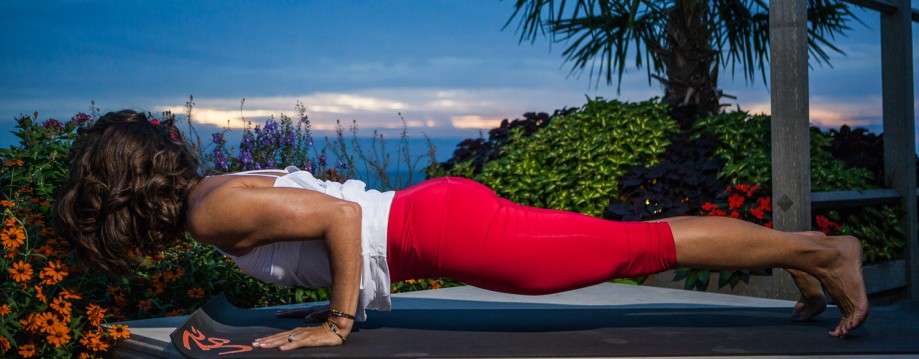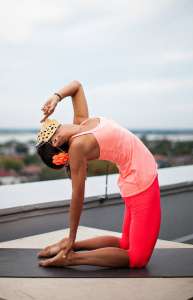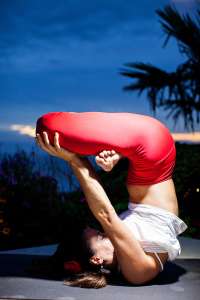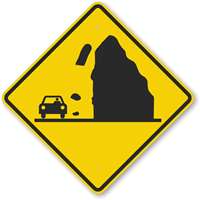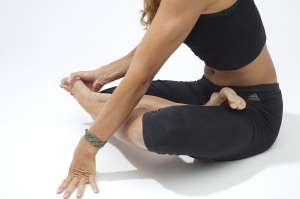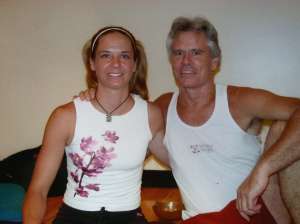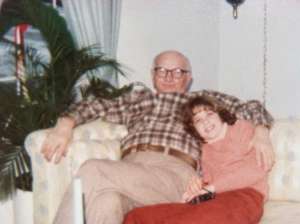If I move left, you move left, and if you move right, I move right. If the group moves up we all go with it. We bob and weave, we ebb and flow, we juke and jive, we move together in all directions and pretty much in unison. There is a great comfort in this uniformity. It provides a certain degree of mental safety. There’s a sense of stability because we are all doing the same thing. It’s nice to know the people surrounding me made the same decision I did today – do your practice. That you packed your yoga bag just as I did this morning to ensure there wouldn’t, couldn’t be any cop-out. That you are breathing, the way I am breathing, that you will struggle as I will struggle, that you will surrender as I will surrender. Not all of these things will happen at the exact same time, but they are bound to happen over the course of our time together, and this provides me great comfort.
Ashtanga yoga does it right. Uniting like-minded people in a room for an hour and half helps us see our similarities instead of our differences. Our community will be built. Our tribe is being formed. You’ve heard the proverb, “It takes a village.” this is my village. This creation of commonality could be the cure for what divides us and creates war.
I often say to my students “that you have at least one thing in common with everyone one in this room today, and that is – you wanted to do your practice.” You all woke up with the same plan – “Must practice yoga!” Go beyond that and see that you have even more in common with your classmates. There may be several of you that are mothers, there may be some of you that are runners, some of you raised by a single parent, some with fear of heights, some with a love of classical music, some that enjoy the same beer and some that have fur-children. If we were to stop everyone at the door and survey each person we could probably lump you together in a bunch of different ways. If we could make you realize all the things you have in common, it would help you feel connected to something that doesn’t have limits. This infinite possibility of connection is bigger than we realize. The potential that comes out of working together way out weighs the struggle you feel when working against each other.
In life, we have many circles. Little communities that make us feel part of something bigger. But why is it that we aren’t feeling more united? We feel that technology is separating us more and more, but everyday I see people uniting in their yoga practice. Especially if its ashtanga yoga, and even more so if its second series that they are practicing. Almost everyone needs help with Supta Vajrasana. I love that we are there for each other with this pose and that there is a forced eye to eye contact that happens on that last exhale up out of Little Thunderbolt. Yoga has a word for all this uniting we experience in and amongst our yoga friends – sangha. No matter the word, sangha, tribe, school, or parade it means the same thing – stick together.
Nature has been on to this little hidden secret for years. Fish stick together in a school, lions stick together in a pride, when crows stick together it’s called a murder, when giraffes stick together it’s called a tower, and when elephants stick together it’s called a parade. This should make us realize that we are stronger as a pack, than we are as individuals. I know I feel this way when I practice yoga with my tribe. Animals realize they are safer in numbers, and ashtangi’s do too.
See yoga’s big goal, or its climax to speak of, is oneness. This union with just one thing and this one thing is powerful enough to make us feel complete, whole, connected, whatever you want to call it. Pattbhi Jois often said “Looking…only God seeing.” It’s cool if it’s not “God” for you, but it is a union to something. When we do our OM we resonate with this one universal sound, and we realize everything vibrates together at some level. Everything and everyone is connected at some level. Recently my sister-in law realized she had met my husband about 15 years before I met him. She was on vacation in Myrtle Beach, SC with her family and my husband flew her and her sister on a parasail ride up and down the coast. She even has a picture to prove this chance meeting. We say it’s a small world, but is it really? I have several more stories of this kind of chance meeting, as I am sure you do too. It’s time that we realize we are all connected.
I took a workshop years ago with Shiva Rae, it was her trademark trance dance workshop. She had us do this thing that I was positive was never going to work. She had us move around a small yoga room, spinning in circles with our arms out for 10 mins. During that 10 minutes she said ” just keep moving by looking for the open spot and you won’t bump into each other.” You know what? It worked! What if practicing yoga could be that simple “Just look for the open spot, and move there.” Just like looking for a parking spot at the grocery store. Find the opening, right? Because that’s where the light shines in.
 If all of us show up on our mats and look for the opening where the light shines in there is bound to be a radiance equal to that of the sun, where for a moment you find yourself completely entranced with the people surrounding you. That you find yourself in a trance dance with your school of yogi’s – flowing on the same current, the same vibration, going in the same direction and moving as one. That at least once during the practice maybe more, you will feel like one brilliant light, you will sound like one giant lung, and you will feel like a school, or a pride, or a flock. If it’s a really good day you might feel like a parade.
If all of us show up on our mats and look for the opening where the light shines in there is bound to be a radiance equal to that of the sun, where for a moment you find yourself completely entranced with the people surrounding you. That you find yourself in a trance dance with your school of yogi’s – flowing on the same current, the same vibration, going in the same direction and moving as one. That at least once during the practice maybe more, you will feel like one brilliant light, you will sound like one giant lung, and you will feel like a school, or a pride, or a flock. If it’s a really good day you might feel like a parade.
